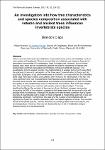An investigation into how tree characteristics and species composition associated with veteran and ancient trees influences invertebrate species
| dc.contributor.author | Clapp, B. | |
| dc.date.accessioned | 2023-12-22T15:41:18Z | |
| dc.date.available | 2023-12-22T15:41:18Z | |
| dc.date.issued | 2023 | |
| dc.identifier.citation |
Clapp, B. (2023) 'An investigation into how tree characteristics and species composition associated with veteran and ancient trees influences invertebrate species', The Plymouth Student Scientist, 16(2), pp. 224-252. | en_US |
| dc.identifier.uri | https://pearl.plymouth.ac.uk/handle/10026.1/21838 | |
| dc.description.abstract |
Veteran and ancient trees have distinctive characteristics that act as microhabitats: such as tree cavities and deadwood. These trees and their microhabitats are keystone features for specialised communities of invertebrates, fungi, and epiphytes. However, due to limited species data, there are still uncertainties around the relative importance of veteran and ancient trees and their associated microhabitats on these invertebrate species. This investigation aims to assess how the tree characteristics of veteran and ancient trees affect the species richness and composition of the three taxa (i) invertebrates, (ii) fungi, and (iii) epiphytes. Epiphytes, fungi, and invertebrates on the tree trunk were recorded and identified; pitfall traps were also installed and collected after 48 hours for identification in the lab. The most significant tree host characteristics that impacted species richness and community structure were the tree size, measured as the diameter at breast height (m) and the number and quality of tree cavities found only on veteran and ancient trees. Due to the low sample size, the ancient tree was combined with veteran trees for data analysis. Tree size significantly affected the variation in the number of microhabitats between tree species, accounting for 68% of the variation, suggesting that larger trees that are generally older will provide more microhabitats. Although the ancient and veteran trees combined had a higher diversity of invertebrates with a mean of three compared to mature trees with two, it was not statistically significant. Furthermore, tree size and the number of microhabitats did not significantly impact the variation associated with invertebrate species richness. Tree cavities benefit invertebrate species, with the wood mould providing stable levels of moisture, pH, and temperature. However, this was not observable due to the invertebrates being in diapause during the sampling period. | en_US |
| dc.language.iso | en | en_US |
| dc.publisher | University of Plymouth | en_US |
| dc.rights | Attribution 3.0 United States | * |
| dc.rights.uri | http://creativecommons.org/licenses/by/3.0/us/ | * |
| dc.subject | Microhabitats | en_US |
| dc.subject | characteristics | en_US |
| dc.subject | species richness | en_US |
| dc.subject | composition | en_US |
| dc.subject | trees | en_US |
| dc.title | An investigation into how tree characteristics and species composition associated with veteran and ancient trees influences invertebrate species | en_US |
| dc.type | Article | en_US |
| plymouth.issue | 2 | |
| plymouth.volume | 16 | |
| plymouth.journal | The Plymouth Student Scientist |




